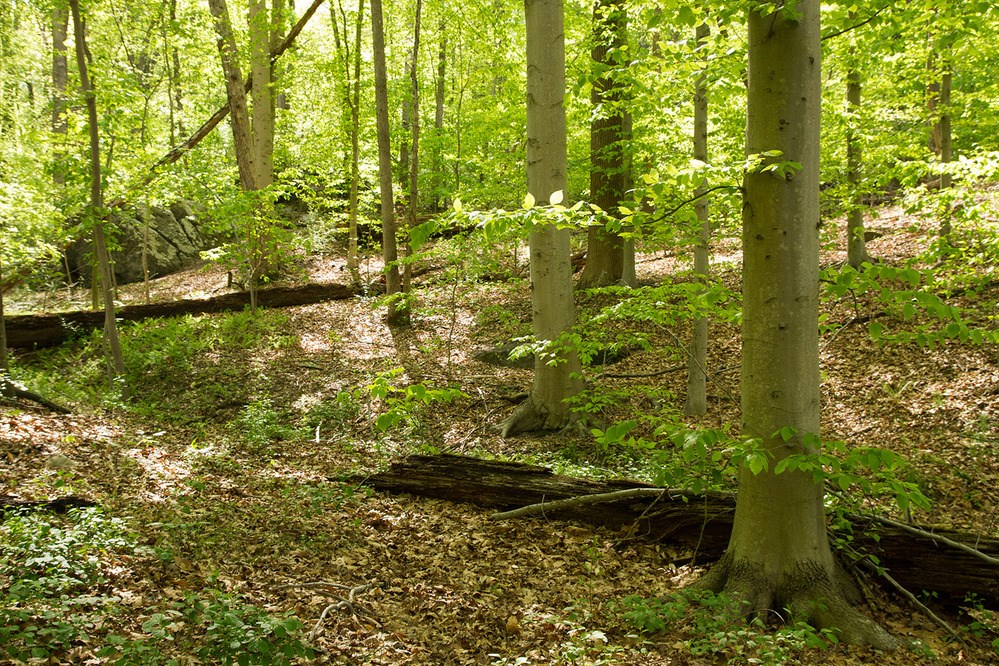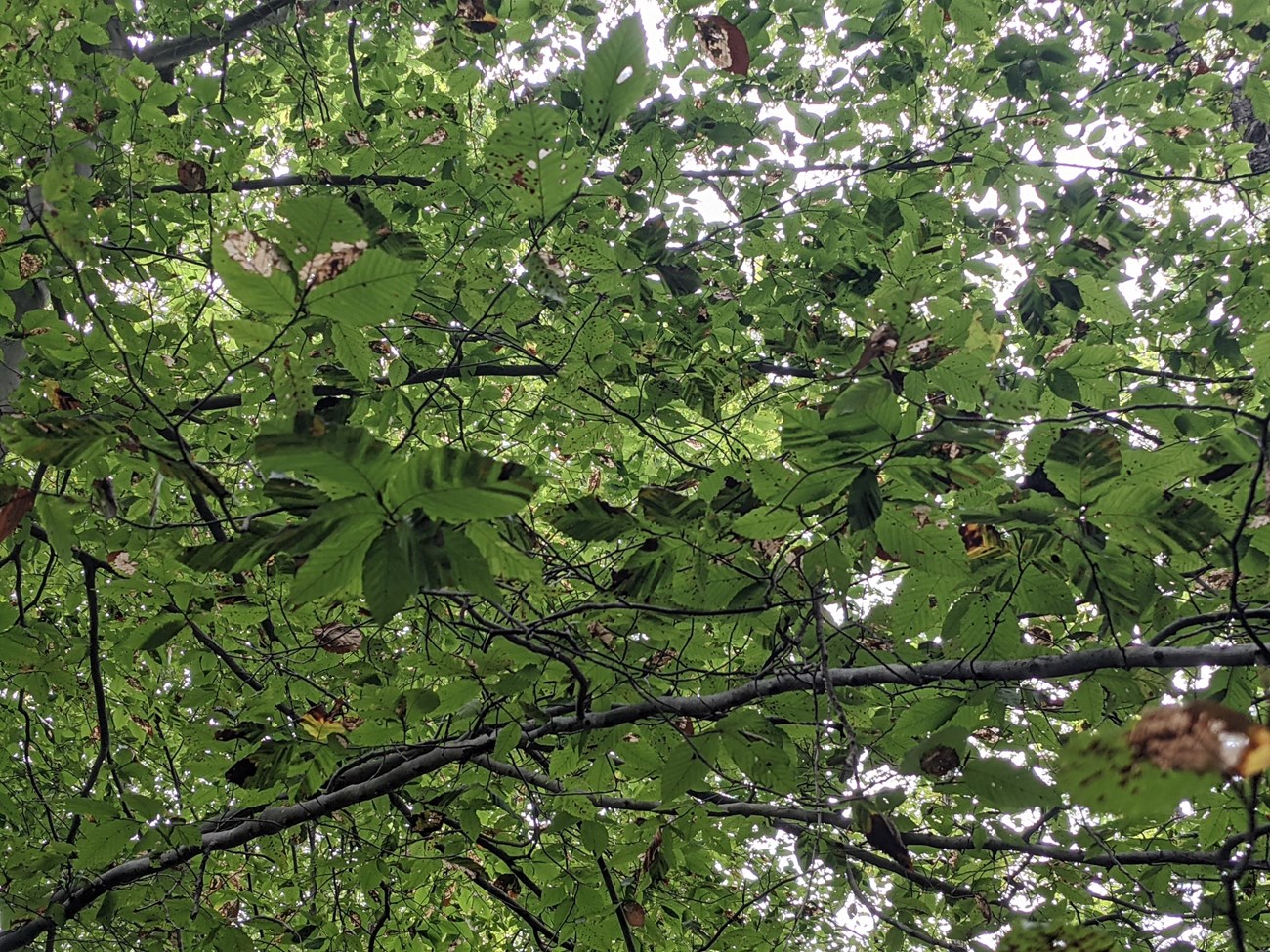Last updated: November 26, 2025
Article
Beech Trees in the National Capital Area

NPS / Sam Sheline
American beech (Fagus grandifolia), the most common tree species in National Capital Area parks, is currently facing the emerging threat of Beech Leaf Disease (BLD).
BLD was confirmed in Prince William Forest Park in 2021. The disease attacks the buds of beech trees, damaging leaves, and eventually killing the buds entirely. Infected trees die over several years as the number of healthy leaves declines. Since the disease was first spotted in Cleveland in 2012, it has been the subject of much study.
Recently, scientists have discovered that BLD is associated with Litylenchus crenatae ssp. mccannii, a microscopic nematode worm present in infected trees. It is currently a mystery how the nematodes spread over long distances, and treatments for the disease are still in the development stage.
Beech Trees in the National Capital Region Network (NCRN)
The NPS National Capital Region Network (NCRN) of the Inventory & Monitoring (I&M) program maintains a network of over 400 vegetation monitoring plots in the parks of the National Capital Area. Data from those plots show that beech trees are among the most abundant trees in the NCRN parks. In recent years, beech has overtaken tulip popular and red maple, to become the most common tree in NCRN parks as whole (see Table 1).
Table 1. Top ten tree species in National Capital Region Network parks (based on 2016-2019 data).
|
Species |
Latin Name |
Trees/ha |
% of Trees |
|
American beech |
Fagus grandifolia |
43.9 |
11.3 |
|
Tulip poplar |
Liriodendron tulipifera |
42.2 |
10.9 |
|
Red maple |
Acer rubrum |
39.9 |
10.3 |
|
Blackgum |
Nyssa sylvatica |
24.9 |
6.4 |
|
White oak |
Quercus alba |
24.2 |
6.2 |
|
Box elder |
Acer negundo |
23.2 |
6.0 |
|
Virginia pine |
Pinus virginiana |
22.7 |
5.9 |
|
Chestnut oak |
Quercus prinus |
14.0 |
3.6 |
|
Eastern redcedar |
Juniperus virginiana |
10.0 |
2.6 |
|
Sweetgum |
Liquidambar styraciflua |
9.8 |
2.5 |
If BLD and other diseases stay contained and don’t spread, we would expect the prevalence of beech in the NCRN parks will continue to increase, as 20% of all saplings are beech (Table 2). Beech saplings are second only to pawpaw (Asimina triloba)—which is unpalatable to deer and accounts for 25% of all saplings— and far more abundant than other common trees, such as tulip popular (<1%) and red maple (4%).
How will Beech Leaf Disease impact parks?
While beech is an important tree across the NCRN, it is far more common in some parks than others (see Table 2). Based on I&M monitoring data, there are several parks: Prince William Forest Park (PRWI), Rock Creek Park (ROCR), George Washington Memorial Parkway (GWMP), Chesapeake & Ohio Canal National Historical Park (CHOH) at the Potomac Gorge, Monocacy National Battlefield (MONO), and National Capital Parks - East (NACE) where beech is in the top five most common tree and sapling species. In these parks, impacts of BLD are expected to be widespread and noticeable.
In parks such as Catoctin Mountain Park (CATO), Antietam National Battlefield (ANTI), Harpers Ferry National Historical Park (HAFE), Wolf Trap National Park for the Performing Arts (WOTR), and Manassas National Battlefield Park (MANA), beech is much less common and impacts to forests from BLD will be less severe. Note that although there are no beech trees in monitoring plots at Manassas, beech does occur in the park in small numbers.
Table 2. Abundance of beech by park 2016-2019 in the National Capital Region Network. [Updated abundance data from 2020-2024.]
|
Park |
TREES/ |
% of TREES |
Rank of Beech |
SAPLINGS/ ha |
% of SAPLINGS |
Rank |
|
all NCRN |
43.9 |
11% |
n/a |
171 |
20% |
n/a |
|
PRWI |
96.4 |
21% |
1st |
410 |
36% |
1st |
|
ROCR |
54.4 |
17% |
2nd |
298 |
44% |
1st |
|
GWMP |
31.8 |
10% |
2nd |
136 |
16% |
2nd |
|
CHOH – Potomac Gorge |
25.0 |
7% |
5th |
50 |
4% |
4th |
|
MONO |
25.5 |
7% |
3rd |
71 |
12% |
3rd |
|
NACE |
23.3 |
6% |
5th |
37 |
4% |
6th |
|
CATO |
12.6 |
5% |
7th |
12 |
6% |
5th |
|
ANTI |
12.0 |
4% |
7th |
36 |
4% |
6th |
|
HAFE |
10.6 |
3% |
9th |
6 |
1% |
12th |
|
CHOH – entire park |
7.2 |
2% |
17th |
17 |
2% |
7th |
|
WOTR |
4.7 |
1% |
13th |
0 |
- |
- |
|
MANA |
0 |
- |
- |
0 |
- |
- |
Effects of Beech Leaf Disease
One of the first impacts of BLD spread will likely be mortality of saplings and small trees. This will be particularly challenging for parks such as Rock Creek, where beech make up a significant percentage of the sapling layer. Deer overbrowsing has already reduced forest regeneration in much of the NCRN and has limited the diversity of trees that are regenerating. Management of deer populations will be a crucial tool for sustaining healthy forests in face of this disease.
As the disease progresses within a tree, branches die and the canopy noticeably thins. With a thinner canopy, more light reaches the forest floor. This could allow invasive plants to flourish and crowd out native vegetation, or for other tree species to take the place of dying beech. In much of the eastern U.S., oak and hickory populations are decreasing, and species that like humid forest environments, such as beech, maple, and blackgum are taking their place. As beech canopies thin, managers can prioritize invasive plants control to allow regeneration of tree species that were previously suppressed by beech trees.
Learn More about the National Park Service's Inventory & Monitoring Efforts
To help protect natural resources ranging from bird populations to forest health to water quality, National Park Service scientists perform ecological Inventory & Monitoring (I&M) work in parks across the country. The National Capital Region Network, Inventory & Monitoring program (NCRN I&M) serves national parks in the greater Washington, DC area. Learn more about NCRN I&M monitoring.

NPS/Brolis
Tags
- antietam national battlefield
- baltimore-washington parkway
- catoctin mountain park
- chesapeake & ohio canal national historical park
- civil war defenses of washington
- fort dupont park
- fort foote park
- fort washington park
- george washington memorial parkway
- glen echo park
- great falls park
- greenbelt park
- harpers ferry national historical park
- kenilworth park & aquatic gardens
- manassas national battlefield park
- monocacy national battlefield
- national capital parks-east
- oxon cove park & oxon hill farm
- prince william forest park
- rock creek park
- theodore roosevelt island
- wolf trap national park for the performing arts
- beech trees
- american beech
- forest
- vegetation
- trees
- fagus grandifolia
- beech leaf disease
- bld
- disease
- forest pests
- invasive pests
- i&m
- ncrn
- resilient forest management
- natural resource quarterly
- winter 2021
- resource brief
